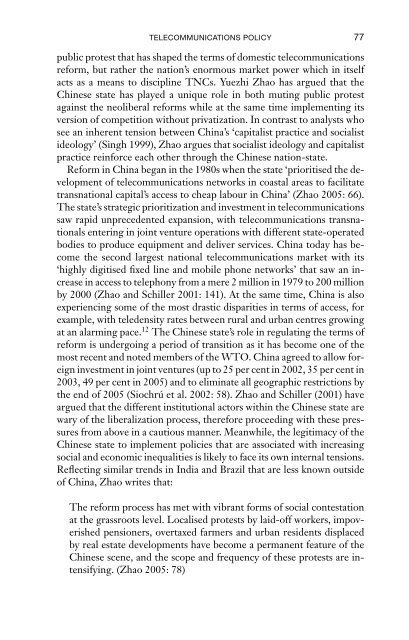Media Policy and Globalization - Blogs Unpad
Media Policy and Globalization - Blogs Unpad
Media Policy and Globalization - Blogs Unpad
Create successful ePaper yourself
Turn your PDF publications into a flip-book with our unique Google optimized e-Paper software.
TELECOMMUNICATIONS POLICY 77<br />
public protest that has shaped the terms of domestic telecommunications<br />
reform, but rather the nation’s enormous market power which in itself<br />
acts as a means to discipline TNCs. Yuezhi Zhao has argued that the<br />
Chinese state has played a unique role in both muting public protest<br />
against the neoliberal reforms while at the same time implementing its<br />
version of competition without privatization. In contrast to analysts who<br />
see an inherent tension between China’s ‘capitalist practice <strong>and</strong> socialist<br />
ideology’ (Singh 1999), Zhao argues that socialist ideology <strong>and</strong> capitalist<br />
practice reinforce each other through the Chinese nation-state.<br />
Reform in China began in the 1980s when the state ‘prioritised the development<br />
of telecommunications networks in coastal areas to facilitate<br />
transnational capital’s access to cheap labour in China’ (Zhao 2005: 66).<br />
The state’s strategic prioritization <strong>and</strong> investment in telecommunications<br />
saw rapid unprecedented expansion, with telecommunications transnationals<br />
entering in joint venture operations with different state-operated<br />
bodies to produce equipment <strong>and</strong> deliver services. China today has become<br />
the second largest national telecommunications market with its<br />
‘highly digitised fixed line <strong>and</strong> mobile phone networks’ that saw an increase<br />
in access to telephony from a mere 2 million in 1979 to 200 million<br />
by 2000 (Zhao <strong>and</strong> Schiller 2001: 141). At the same time, China is also<br />
experiencing some of the most drastic disparities in terms of access, for<br />
example, with teledensity rates between rural <strong>and</strong> urban centres growing<br />
at an alarming pace. 12 The Chinese state’s role in regulating the terms of<br />
reform is undergoing a period of transition as it has become one of the<br />
most recent <strong>and</strong> noted members of the WTO. China agreed to allow foreign<br />
investment in joint ventures (up to 25 per cent in 2002, 35 per cent in<br />
2003, 49 per cent in 2005) <strong>and</strong> to eliminate all geographic restrictions by<br />
the end of 2005 (Siochrú et al. 2002: 58). Zhao <strong>and</strong> Schiller (2001) have<br />
argued that the different institutional actors within the Chinese state are<br />
wary of the liberalization process, therefore proceeding with these pressures<br />
from above in a cautious manner. Meanwhile, the legitimacy of the<br />
Chinese state to implement policies that are associated with increasing<br />
social <strong>and</strong> economic inequalities is likely to face its own internal tensions.<br />
Reflecting similar trends in India <strong>and</strong> Brazil that are less known outside<br />
of China, Zhao writes that:<br />
The reform process has met with vibrant forms of social contestation<br />
at the grassroots level. Localised protests by laid-off workers, impoverished<br />
pensioners, overtaxed farmers <strong>and</strong> urban residents displaced<br />
by real estate developments have become a permanent feature of the<br />
Chinese scene, <strong>and</strong> the scope <strong>and</strong> frequency of these protests are intensifying.<br />
(Zhao 2005: 78)

















